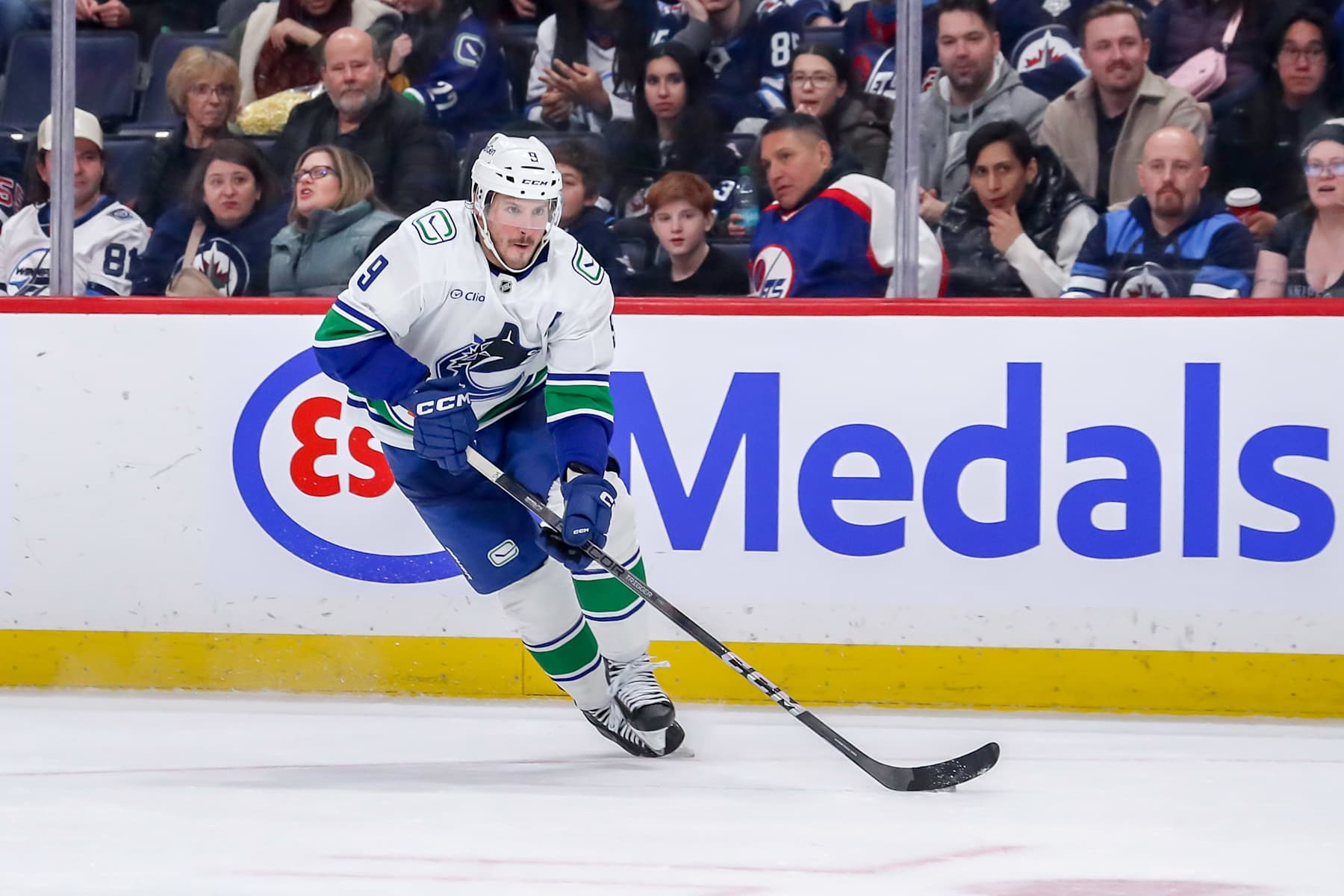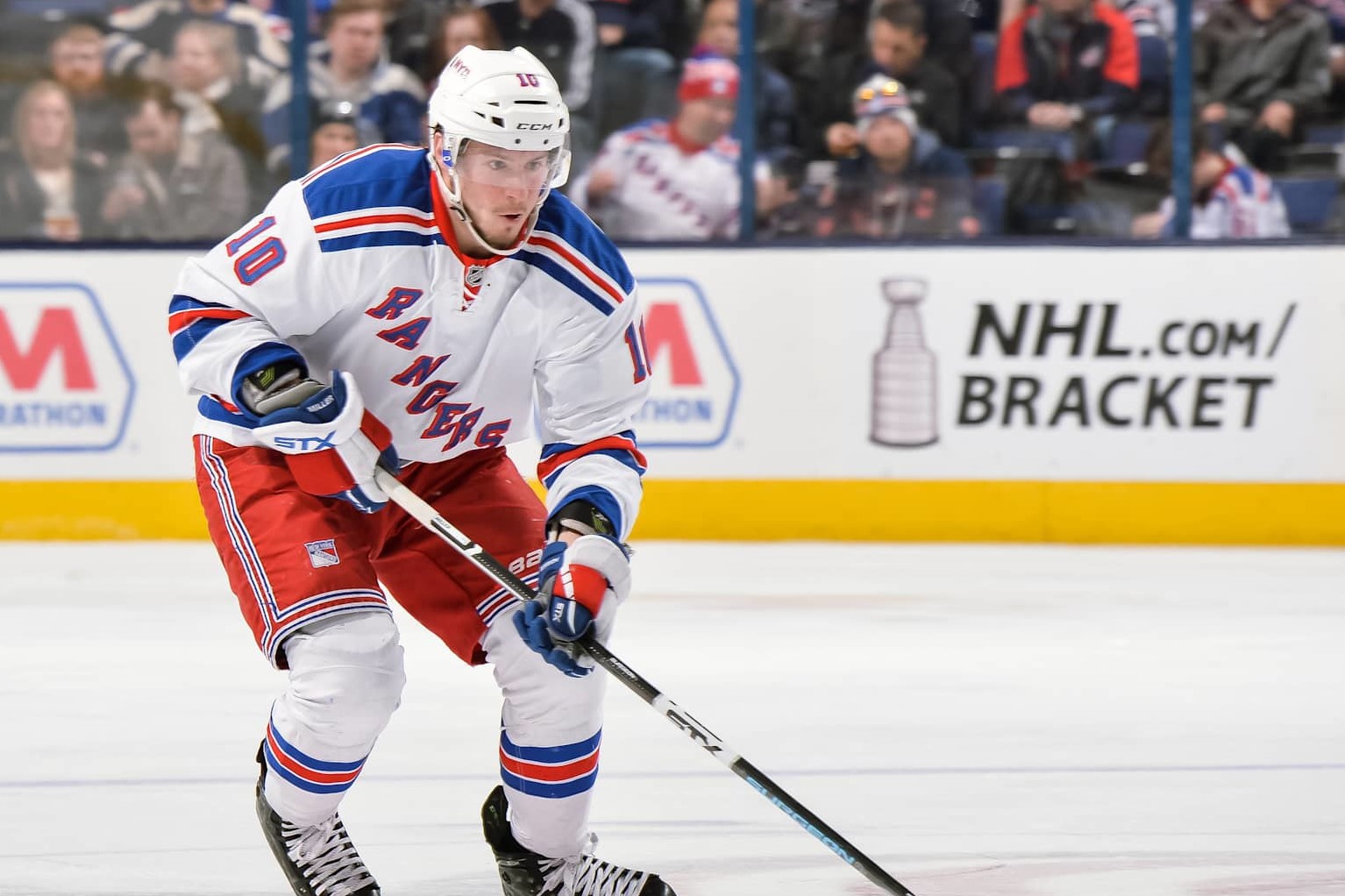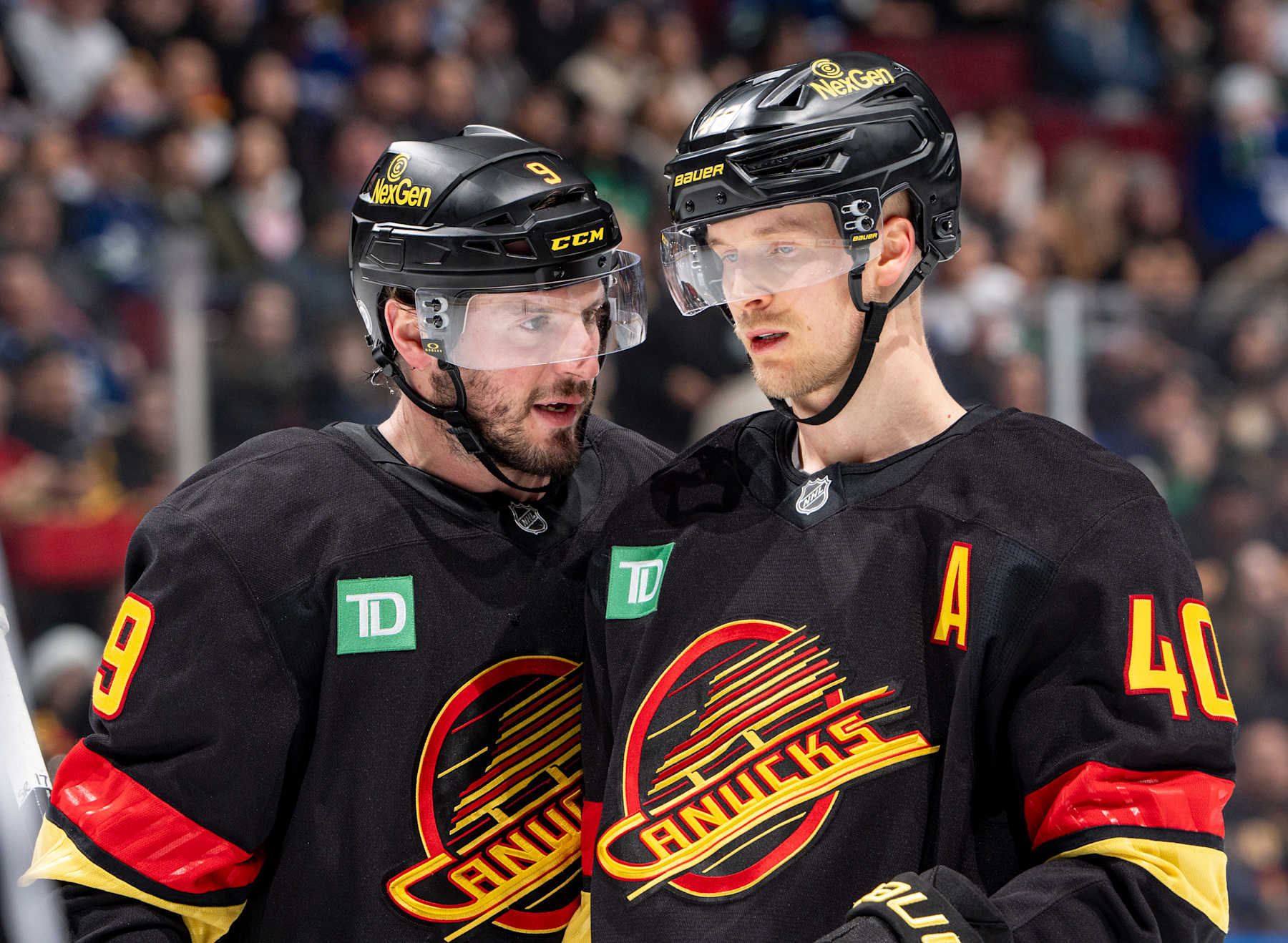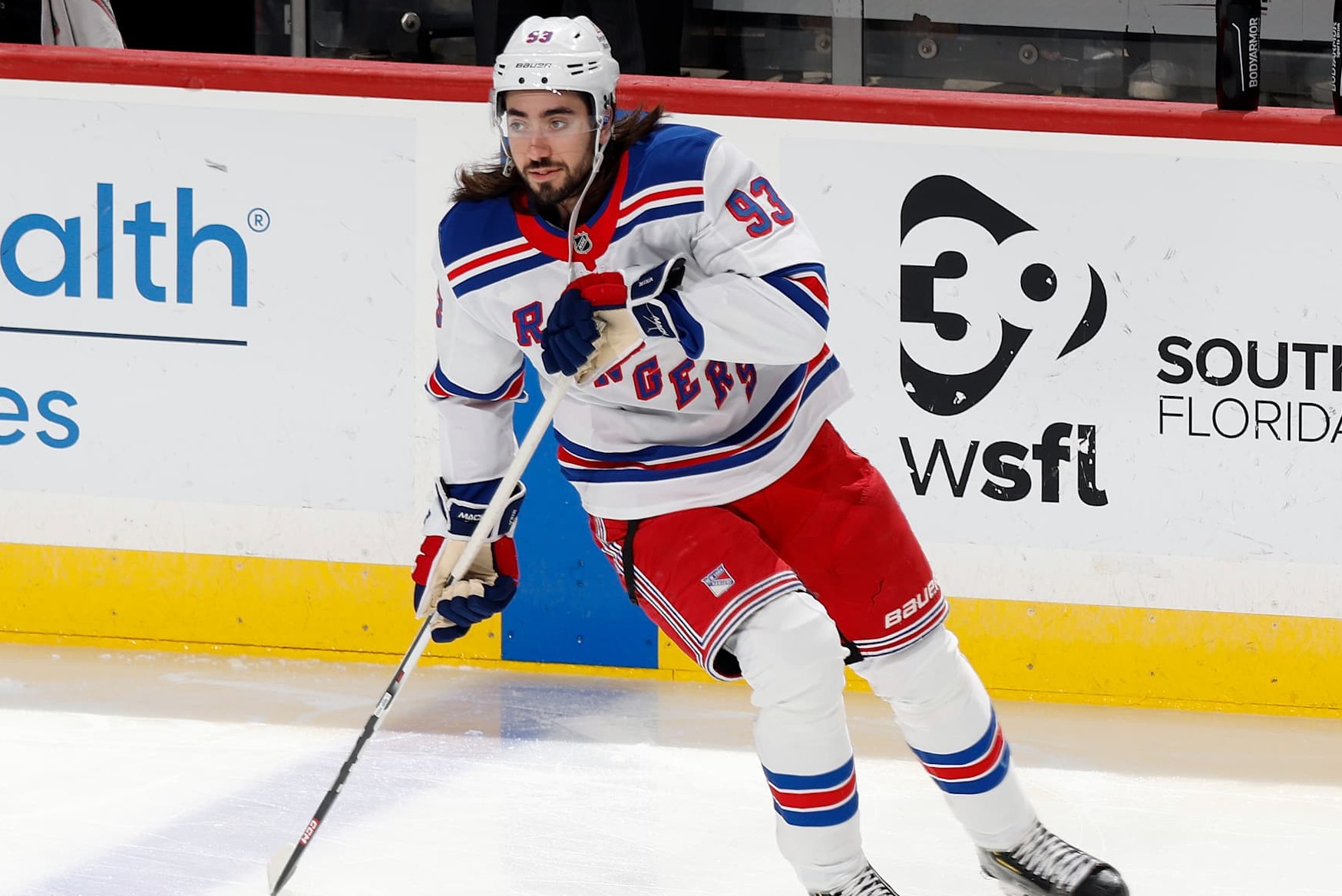N/A
J.T. Miller
NHL News: J.T. Miller Reportedly Traded to Rangers; Canucks Get Filip Chytil, More

J.T. Miller is reportedly headed back to Manhattan.
The New York Rangers and Vancouver Canucks agreed to a trade that will bring Miller back to where his NHL career began in 2013, per the Daily Faceoff's Frank Seravalli.
The Canucks are also sending defenseman Erik Brännström and NCAA prospect Jackson Dorrington to New York, per Larry Brooks of the New York Post.
In return the Canucks will receive veteran center Filip Chytil, rookie defenseman Victor Mancini and a protected 2025 first-round pick, according to Brooks, Seravalli and ESPN's Emily Kaplan.
The pick is top-13 protected and could potentially slide to 2026, per Seravalli.
Miller is expected to join the Rangers for Saturday night's game against the Boston Bruins, per Kaplan.
The report comes after The Athletic's Rick Dhaliwal said Miller would be scratched for the Canucks' Friday night road game against the Dallas Stars.
Miller had a full no-move clause on his contract, which he would have had to waive to facilitate the deal.
The alternate captain has been at the center of trade rumors this season amid a reported rift between himself and Canucks defenseman Elias Pettersson. Miller has previously told reporters the feud was "created" by the media.
The Athletic's Josh Yohe reported in early January the Canucks had turned down a trade offer for Miller that would have sent Mika Zibanejad to Vancouver. Friedman later added that the talks stalled because the Canucks didn't include Braden Schneider in the deal.
Miller was almost held out of a home game against the Edmonton Oilers on Jan. 18 because of a potential trade with the New York Rangers, according to Sportsnet's Elliotte Friedman. The deal "would have involved multiple players and draft picks," per ESPN's Greg Wyshynski.
The Canucks had also discussed trade scenarios involving Pettersson, according to Wyshynski. But after the latest round of negotiations with the Rangers proved more successful, it will ultimately be Miller leaving Vancouver less than one year after leading the Canucks to the second round with the best season of his career.
Miller paced the Canucks with 103 points in 81 regular-season games in 2023-24 to help Vancouver win 50 games for the first time since the Henrik and Daniel Sedin era.
Although the Canucks were eliminated in seven games by the Edmonton Oilers on their way to the Stanley Cup Finals, the hope was that Quinn Hughes' team would regroup and go on a deeper run in 2025.
But bad injury luck including the extended absence of starting netminder Thatcher Demko, combined with the scrutiny surrounding the relationship between Miller and Pettersson, have exacerbated what has already been a difficult start to the 2024-25 season. The reigning Pacific Division leaders are fighting for a wild card spot as the trade deadline approaches.
Miller has played for the Canucks since he was traded to Vancouver by the Tampa Bay Lightning ahead of the 2019-20 season.
After three straight 30-goal seasons, his production dipped early in the 2024-25 campaign to nine goals and 26 assists for 35 points in 40 games.
The center, who turns 32 in March, made his NHL debut with the Rangers in 2013. He played 341 regular-season games and 40 postseason contests for the franchise prior to his 2018 trade to the Lightning.
Having grown into as a second-line center in Vancouver, Miller will likely be taking on a larger role in New York this time around.
Like the Canucks, the Rangers have fallen into a race for a Wild Card spot after an underwhelming start to the season. The team will hope reworking their top six can help spark a playoff push over the second half of the season.
Adding Miller's contract means yet another long-term contract commitment added to New York's crowded salary cap. Miller is signed through the 2029-30 season, with a full no-trade clause through 2026-27 and a 15-team no-trade list over the final three years of the deal, according to Spotrac.
NHL Rumors: Rangers' Trade Offer of Mika Zibanejad for JT Miller Rejected by Canucks

The Vancouver Canucks reportedly turned down an offer from the New York Rangers to trade Mika Zibanejad for J.T. Miller earlier this season, according to The Athletic's Josh Yohe.
Both Miller and Zibanejad hold a no-move clauses. Even if the Canucks had pursued the trade, both players would have had to agree to the swap.
Sportsnet's Nick Kypreos did recently report he believes Miller would be willing to waive his no-move clause in order to go to the Rangers.
Despite a goalscoring slump Miller is having the more productive season of the pair, with 29 points (eight goals, 21 assists) in 29 contests. Zibanejad has meanwhile recorded 24 points (eight goals, 16 assists) while skating in ten more games.
Rangers general manager Chris Drury has been open about his willingness to trade core players this season. Drury went so far as to send a memo to all 31 teams advertising the availability of roster members in November, as reported by Sportsnet's Elliotte Friedman and confirmed by multiple sources.
The Rangers have since traded captain Jacob Trouba to the Anaheim Ducks and forward Kaapo Kakko to the Seattle Kraken.
Those deals have yet to spark a resurgence for a team that went into the season expecting to be a playoff contender. The Rangers headed into the New Year outside of the playoff bubble and trailing only the Buffalo Sabres for the most regulation losses (20) in the Eastern Conference.
The Canucks are looking for a deadline shakeup of their own, according to Friedman. The NHL insider recently said on an episode of The FAN Hockey Show that tension between Miller and Canucks forward Elias Pettersson "has begun to spill over elsewhere into the organization."
Pettersson does not have a no-trade clause, although his contract will present a challenge should the Canucks decide to turn to a trade to resolve the reported split. The forward is in the first year of an eight-year, $92.8 million deal that has him set to remain on the books through the 2031-32 season.
The Canucks and Rangers both made it to the second round last season, with the Rangers getting as far as the Eastern Conference Final. Given that neither team currently looks on track for a deeper run, there's still a chance they could look to shake things up by moving Miller or Zibanejad before the March 7 trade deadline.
Would a J.T. Miller Trade Fix the Rangers' Problems at Center?

With the Rangers struggling for months now, there is general alignment on what—and who—are the problems. Jacob Trouba and Kaapo Kakko were merely the early departures in what is expected to be a mass exodus for a roster that has largely stayed the same the last few seasons.
Assigning blame and tearing down the walls is the easy part of a roster restructuring. The Rangers aren't headed for a rebuild but this is a team missing key pieces at prominent positions. Mika Zibanejad's sharp decline and Vincent Trocheck's return to reality leave Head Coach Peter Laviolette with zero answers at first-line center. Solutions are hard to come by. There aren't many high-caliber centers and the teams that have them don't typically let them get away.
The Rangers may hope that the answer to turbulence in Manhattan may be friction elsewhere. General Manager Chris Drury has been after J.T. Miller for multiple years. A fracture between Miller and Elias Pettersson has made things uncomfortable in Vancouver and the Canucks may be forced to deal one or the other.
Now, a return to New York for Miller feels like a possibility rather than a daydream. The 31-year-old would undoubtedly be a big swing on talent and would change the locker room dynamic. But is Miller a true solution as a first-line center? Under what conditions would a move make sense for the Rangers?

What Miller Could Bring to the Rangers
Miller is one of the best offensive producers in the league. Over the previous three seasons, he ranked 10th among all NHLers by points, with 285 in 242 games.
The American is dynamic with the puck in the offensive zone. A dual threat who leans playmaker, Miller is at his best when he's making plays in motion. What the Rangers presumably like, though, is that he is not only a perimeter player. Yes, Miller can create from the outside, but he also has no problems crashing the net and fighting for ugly goals. He finds rebounds and deflections.
With Chris Kreider off his game and potentially on the way out, the Rangers could use some more chaos from a high-caliber player around the net front. In those regards, Miller does match first-line billing.
He undoubtedly would bring a different type of persona to a Rangers locker room that has gone stale. Miller is very vocal and carries himself with a certain arrogance that, in the right moments, can bring life to an arena. Even when the Rangers were at their best last season, the makeup of team leadership was calm and quiet, even if confident. Now that everyone's gone downhill without much pushback from team leadership, there is room for someone who could come in and shake things up.
Different Player, Same Problems?
A "grass is always greener" dynamic is at full throttle among the New York fanbase at the moment where seemingly every player in-house is irredeemable and any big addition who would shake up the status quo is, therefore, perceived as a solution.
In reality, it's not clear that Miller would change too much about what's wrong in New York. The best version of this team, such as the one that won the Presidents' Trophy last season, is still a heavily flawed one in critical areas. They are on their heels at five-on-five. They struggle to move play into the offensive zone and bleed chances defensively. The team lacked a true marquee first-line center who could anchor the team in most areas of the game.
Miller may have been 10th in points the previous three seasons, but 43.1 percent of that production came on the power play. At five-on-five, Miller drops down to 33rd among all NHLers over that span. Keep in mind, too, that he created much of that offense either in Elias Pettersson's shadow as a second-line center or shifted to the wing.

Miller fits much of the Rangers' already existing profile, too, in that he is an offensive zone creator rather than a significant driver of play. He is fantastic at generating offense past the blue line, and his cycle offense may indeed bring something new to a one-and-done group in New York, but he's nothing special in terms of helping his team establish possession in the offensive zone in the first place. The Rangers are desperate for excellence in terms of winning possession on the forecheck, creating zone entries, or retrieving pucks and establishing the breakout. Miller has varying degrees of competency in those areas but he's nowhere close to a focal point in any.
The biggest worry, though, has to be Miller's defensive game. At his best moments, he merely keeps his head above water. More often, he is a net-negative defensively. Maybe Miller can give the Rangers first-line firepower offensively but gives the Rangers similar issues as they have had with Zibanejad when it came with trying to match a Sasha Barkov or shut down a Jack Hughes.
A Volatile Player for an Uncertain Environment
And this all supposes a highly functioning Miller. Rangers fans have harangued Mika Zibanejad for being seemingly disengaged and completely absent at five-on-five, and that's mostly fair. But what of Miller this season? He has just one goal at even strength this season and seven total points at five-on-five in his last 20 games.
Inconsistencies have plagued Miller his whole career and that dial has been turned up to maximum this season. He's prone to lackadaisical or unfocused shifts with either haphhazard attention to defensive duties or careless turnovers in vulnerable spots.
And of course, the entire reason Vancouver might trade him is because of irreconcilable differences in the locker room. Miller may inject some passion into a very vanilla Rangers locker room. Or, he could be a headache in an already uneasy team atmosphere.
A Fit for New York... in Certain Circumstances
Looking for a cure-all solution to the Rangers' catastrophic collapse is a futile task. The problems are widespread and deep to the degree that one player cannot come in and fix them alone.
At the same time, this is a team with finite resources. Management has a handful of attractive pieces to move in the way of roster players and prospects and somewhat limited draft capital. If Drury is going to empty the coffers, he cannot afford to get anything less than a franchise-changing player.
It's hard to envision Miller as that player. He comes with major question marks that, even if answered favorably, paint him more as an opportunistic offensive producer rather than a first-line center that Stanley Cup teams are accustomed to in the forms of either elite offensive play drivers or 200-foot bulls.
What's more, the big-picture worry for the Rangers is that their contention window is rapidly closing and they are tied to players with big cap hits whose declines are either here or imminent. Miller is a soon-to-be 32-year-old who holds an $8.5 million cap hit through 2030. To the extent that he addresses that problem for the Rangers, it's only by kicking the can down the road a year or two.
If the Rangers can convince Vancouver to swap problems then a move could make a lot of sense. Maybe Zibanejad would welcome a fresh start and a chance to become a second-line center behind Pettersson in Vancouver. In such a case, taking a chance on Miller bringing new life to the Rangers suddenly looks very appealing.

If nothing else, Miller's contract would offer the Rangers more flexibility down the road. Both carry the same $8.5 million cap hit for five more seasons. But whereas Zibanejad has full trade protection until the 2030 trade deadline, Miller's full no-trade clause turns into a 15-team no-trade clause in July 2027. Furthermore, Miller's contract is far less laden with signing bonuses, making him a buyout option down the line, whereas Zibenajad's contract is virtually buyout-proof.
Miller's full control of his destiny at the current moment may too benefit the Rangers. If the atmosphere in Vancouver becomes untenable and the Rangers are the only true suitor for whom Miller is willing to waive his protection, the Blueshirts may be able to acquire him without giving up too many significant assets. If a Miller trade leaves the Rangers with enough key trade pieces remaining to pursue other much-needed additions, then he's certainly worth the gamble on talent. There are certain scenarios in which a Miller trade makes a whole lot of sense for New York.
Overall, though, Miller alone is not enough to overcome the Rangers' bevy of issues or even their need for a true marquee first-line center for the long term. If he is Drury's idea of the big fix to the team's foundation worth moving the house for, then it will only serve to exacerbate the team's decline to longer-term irrelevancy.
NHL Trade Rumors: Canucks' J.T. Miller Eyed by Rangers amid Leave of Absence

The New York Rangers have "recently inquired" about a potential trade for Vancouver Canucks forward J.T. Miller, according to The Athletic's Arthur Staple and Peter Baugh.
Miller last played on Nov. 17 before the Canucks announced he was taking "indefinite leave for personal reasons."
Staple and Baugh called the inquiry "a long shot" due both to Miller's leave and his contract. The 31-year-old forward is currently in the second season of a seven-year, $56 million deal he signed with the Canucks in 2022.
The Rangers also pursued Miller ahead of the 2021-22 trade deadline, but the deal fell apart because New York was unwilling to trade Braden Schneider, per Staple and Baugh.
New York is set to spend $22 million against the cap to pay Artemi Panarin, Adam Fox, Mika Zibanejad and Jacob Trouba next season, per Spotrac. If pending UFA Igor Shesterkin gets an extension, the Rangers are on track to dedicate more than 50 percent of the 2025-26 cap to their top five players.
Add in Alexis Lafrenière, Chris Kreider and Vincent Trocheck and the Rangers already have their core locked in for at least one more season.
That could be a problem for general manager Chris Drury, who Sportsnet's Elliotte Friedman reported on Nov. 25 has "made it very clear they are interested in making moves and shaking up their roster."
"Among the names indicated are Chris Kreider and Jacob Trouba, although other options will be considered," Friedman wrote.
The New York Post's Mollie Walker then reported that Drury "sent a memo to all 31 of his NHL counterparts announcing that the Rangers are open for business."
The memo listed "multiple players as available" other than Kreider and Trouba, Walker reported.
Zibanejad would make the most sense to move out if the Rangers took a swing at a top-line center like Miller.
But Zibanejad has almost a full no-movement clause on his contract, which has him locked in with the Rangers through 2029-30, per Spotrac. Panarin and Trocheck have similar restrictions.
The NHL trade deadline isn't until March 7. With two thirds of the regular season still remaining, other teams may be planning to wait until their playoff hopes— or lack thereof— are clearer before agreeing to a major trade. That will present a challenge to Drury's apparent hopes of securing a significant deal this calendar year.
At 12-8-1, the Rangers sit fourth in the Metropolitan Division and in an Eastern Conference wild card spot through 21 games.
